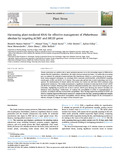Citation link:
https://doi.org/10.1016/j.stress.2024.100569| DC Field | Value | Language |
|---|---|---|
| dc.contributor.author | Hashmi, Muneeb Hassan | - |
| dc.contributor.author | Tariq, Haneef | - |
| dc.contributor.author | Saeed, Faisal | - |
| dc.contributor.author | Demirel, Ufuk | - |
| dc.contributor.author | Gökçe, Ayhan | - |
| dc.contributor.author | Merzendorfer, Hans | - |
| dc.contributor.author | Aksoy, Emre | - |
| dc.contributor.author | Bakhsh, Allah | - |
| dc.date.accessioned | 2025-03-20T09:57:53Z | - |
| dc.date.available | 2025-03-20T09:57:53Z | - |
| dc.date.issued | 2024 | de |
| dc.description | Finanziert aus dem DFG-geförderten Open-Access-Publikationsfonds der Universität Siegen für Zeitschriftenartikel | de |
| dc.description.abstract | Tomato production on a global scale is under persistent pressure due to the devastating impact of Phthorimaea absoluta Meyrick (Lepidoptera: Gelechiidae), the South American tomato leaf miner. To combat this devastating pest, we explored the potential of plant-mediated RNA interference (RNAi) as a novel strategy for its management. Using transgenic techniques, we developed RNAi constructs (p35S::dsAChE1, p35S::dsSEC23) targeting crucial genes, AChE1 and SEC23, in P. absoluta. These genes play pivotal roles in insect physiology and development. The transformation of tomato cultivar Rio Grande was carried out with these RNAi constructs using Agrobacterium tumefaciens. The results demonstrated a significant reduction in transcript levels of both AChE1 and SEC23 in P. absoluta. Silencing AChE1 resulted in substantial mortality rates, reduced larval weight gain, and deformities, highlighting its pivotal role in insect survival. SEC23 gene silencing also induced mortality and influenced insect physiology. Furthermore, we explored the susceptibility of AChE1 to organophosphate insecticides, revealing its relevance in insecticide susceptibility. These findings support the potential of AChE1 and SEC23 as valuable targets for RNAi-based control of P. absoluta for the first time, providing multifaceted insights into insect physiology and insecticide susceptibility, thereby offering valuable insights for the development of effective strategies to mitigate the impact of this destructive pest. | en |
| dc.identifier.doi | https://doi.org/10.1016/j.stress.2024.100569 | de |
| dc.identifier.uri | https://dspace.ub.uni-siegen.de/handle/ubsi/2911 | - |
| dc.identifier.urn | urn:nbn:de:hbz:467-29112 | - |
| dc.language.iso | en | de |
| dc.rights | Attribution-NonCommercial-NoDerivatives 4.0 International | * |
| dc.rights.uri | http://creativecommons.org/licenses/by-nc-nd/4.0/ | * |
| dc.source | Plant Stress ; volume 14, article number 100569. - https://doi.org/10.1016/j.stress.2024.100569 | de |
| dc.subject.ddc | 580 Pflanzen (Botanik) | de |
| dc.subject.other | Rio Grande | und |
| dc.subject.other | Agrobacterium tumefaciens | und |
| dc.subject.other | Transcript level | en |
| dc.subject.other | Mortality | en |
| dc.subject.other | Gelechiidae | en |
| dc.subject.other | Transkript-Ebene | de |
| dc.subject.other | Sterblichkeit | de |
| dc.title | Harnessing plant-mediated RNAi for effective management of Phthorimaea absoluta by targeting AChE1 and SEC23 genes | en |
| dc.type | Article | de |
| item.fulltext | With Fulltext | - |
| ubsi.publication.affiliation | Institut für Biologie | de |
| ubsi.source.issn | 2667-064X | - |
| ubsi.source.issued | 2024 | de |
| ubsi.source.issuenumber | 14 | de |
| ubsi.source.pages | 12 | de |
| ubsi.source.title | Plant Stress | de |
| Appears in Collections: | Geförderte Open-Access-Publikationen | |
Files in This Item:
| File | Description | Size | Format | |
|---|---|---|---|---|
| Harnessing_plant-mediated_RNAi.pdf | 10.43 MB | Adobe PDF |  View/Open |
This item is protected by original copyright |
Page view(s)
32
checked on Mar 28, 2025
Download(s)
3
checked on Mar 28, 2025
Google ScholarTM
Check
Altmetric
This item is licensed under a Creative Commons License


